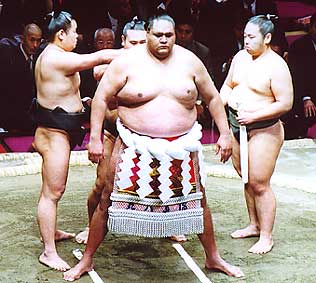Like this post? Help us by sharing it!
 Sumo Wrestling History
Sumo Wrestling History
While Sumo, Japan’s national sport dates back 2000 years, it didn’t begin to flourish as a spectator sport until the early 1600s. Sumo is a full contact sport, where 2 wrestlers, known as Rikshiki compete to force one another out of the ring. While sumo has evolved throughout the centuries, today’s sumo still retains some of the traditions of ancient Japanese tradition.
Today’s rishiki still perform pre-bout ceremonies that are steeped in the tradition of Shinto, Japan’s native religion. Shinto traditions include ceremonies and rituals as opposed to a definite belief system or code of ethics; sumo was performed during festivals to entertain the gods.
Symbolic References to Shinto
- The canopy that is above the ring resembles the roof seen on a Shinto shrine.
- The sand covering the clay of the ring is a symbol of purity.
- Each corner of the canopy has four tassels. Each tassel represents the four seasons.
- The purple bunting around the roof represents the drifting of clouds and season rotation.
- Cuttlefish, chestnuts and kelp are placed in the ring, as well as prayers for safety.
- The referee uniform closely resembles a Shinto priest’s traditional robe.
The Sport of Sumo Wrestling
Only the bottom of the rikishis’ feet can touch the floor. The first rikishi to have any other part of his body touch the floor or that exits the ring, loses.
Practice sessions begin right before and during major tournaments. During these practice bouts in the makeshift ring, the winner remains in the ring until another rikishi beats him. After a bout ends, all the rikishi rush into the ring, in the hope of becoming the winner’s next opponent.
Sumo Moves
Chon-gake
Tip opponent’s right ankle with the right leg or left ankle with left leg and then push him down.
Hataki-komi
Pull opponent down to the ring using his head, shoulders or neck.
Gassho-hineri
Grip the opponent’s head using both hands and twist him down.
The Bout Begins
As the actual bout begins, the two rikishi spend a few minutes before their match scaring away demons by lifting their legs high in the air and then stomping. Each rikishi also throws salt into the ring and around his body. This practice is done to protect him from injuries.
After the Final Bout
The bow twirling (yumi-tori) ceremony is performed by a rikishi who has a makushita, the third highest, rank. True fans of sumo will remain seated until this ritual is completed.
A Cultural Experience
Sumo wrestling history offers insight into the Japanese culture. Because many of the aspects of sumo remain the same, sumo is more than just a sport; it offers a living example of the traditional Japanese culture.
When and Where
There are six major tournaments a year. These tournaments take place in cities all over Japan.
The tournament sites and months are:
- January – Tokyo
- March – Osaka
- May – Tokyo
- July – Nagoya
- September – Tokyo
- November – Fukuoka


